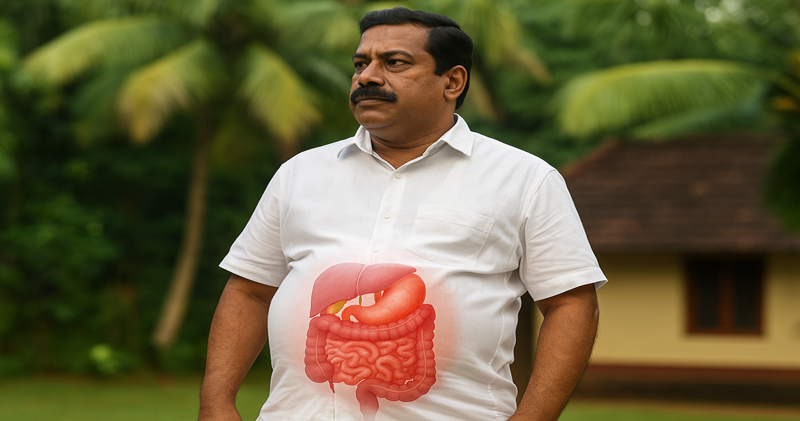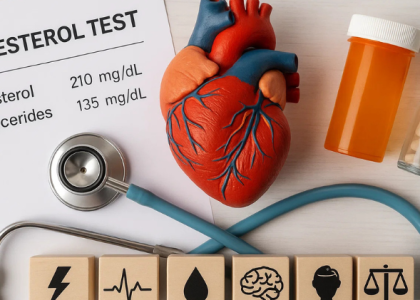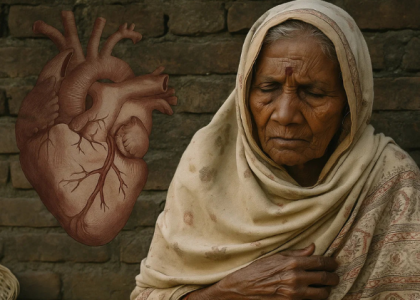We’ve all seen it at family gatherings – uncles with those distinctive round bellies, often jokingly called the “Kerala pouch” or “Malayali middle.” These bellies have been part of our cultural landscape, often developing after years of enjoying our rich, flavorful cuisine that connects us to home and tradition. Yet behind this familiar sight lies an important health concern that deserves your attention.
What Is Visceral Fat? The Hidden Danger Inside
That protruding belly isn’t just about looks or tight clothing. What we’re really talking about is visceral fat – a dangerous type of fat that wraps around your internal organs deep inside your abdomen.
Unlike the fat you can pinch under your skin (called subcutaneous fat), visceral fat actively produces hormones and inflammatory substances that directly damage your heart health. This deep belly fat significantly increases your risk of:
- Heart attacks and stroke
- Type 2 diabetes
- High blood pressure
- Abnormal cholesterol levels
TOFI: Thin Outside, Fat Inside — The Deceptive Condition
Many Kerala men experience a condition doctors now call “TOFI” — Thin Outside, Fat Inside. This means you might look relatively slim in your arms and legs but still carry dangerous amounts of fat around your organs.
This condition is particularly common in South Asians who may have:
- Normal body weight
- Slim arms and legs
- A seemingly modest belly
- Normal or only slightly elevated BMI
Yet despite these “normal” appearances, the internal fat accumulation creates the same risks as someone who appears obviously overweight.
Why Kerala Men Are Particularly Vulnerable
Several factors make Kerala men especially prone to this dangerous fat pattern:
Genetic Predisposition
South Asian men, including Keralites, are genetically programmed to store more fat around their organs rather than under their skin, even at lower body weights.
Dietary Patterns
The traditional Kerala diet has shifted over generations:
- High white rice consumption
- Increased processed foods
- Regular sweets and fried snacks
- Sugary chai and beverages
Lifestyle Factors
Modern life has brought new challenges:
- Sedentary office jobs
- Less daily physical movement
- Increased alcohol consumption
- Poor sleep habits and stress
- Long commutes or sitting hours
Cultural Perceptions
In many Kerala families, a slight belly is sometimes viewed as a sign of prosperity rather than the medical red flag it truly represents.
When to Worry: Measuring Your Risk
The danger starts much earlier for South Asian men compared to other populations:
Waist Measurement — The Simple Test
Take a tape measure around your waist at belly button level while standing:
- Danger zone for South Asian men: 35+ inches (90+ cm)
- This is much lower than the 40-inch guideline for other populations
Beyond the Scale
Even with a “normal” BMI, these signs suggest dangerous visceral fat:
- Any visible belly protrusion
- Difficulty seeing your toes when standing straight
- Pants fitting tighter at the waist while loose in the legs
- Feeling short of breath when bending over
Advanced Screening Tests Worth Considering
Standard cholesterol tests don’t tell the whole story for South Asians. Consider discussing these with your doctor:
Calcium Score Test
This specialized heart scan detects early calcium buildup in coronary arteries, often before symptoms appear. Many South Asian men with normal cholesterol still show concerning calcium scores.
Lipoprotein(a) Test
Lp(a) is a genetic risk factor particularly common in South Asian families. High levels significantly increase heart attack risk but aren’t measured in routine blood work.
Simple Steps to Reduce Your Risk Today
The good news is that visceral fat responds well to lifestyle changes. Start with these three approaches:
Modify Your Diet
- Mix white rice 50/50 with brown rice, millets like ragi, or cauliflower rice
- Add protein to every meal to reduce blood sugar spikes
Reduce Sugar Intake
- Cut back on sugary chai by using half the sugar or substituting with jaggery
- Choose fruit instead of traditional sweets at least four days per week
- Drink water with lemon instead of soda or fruit juice
Increase Movement
- Walk for 10 minutes after meals, especially dinner
- Stand up and move every 30 minutes during work
- Aim for 30 minutes of moderate activity daily – walking is perfectly fine!
Improve Sleep and Stress
- Prioritize 7-8 hours of quality sleep
- Practice 5 minutes of deep breathing daily
- Limit alcohol to occasional consumption
The Heart of the Matter
That Kerala belly isn’t just about appearance — it’s a medical warning sign your heart is asking you to take seriously. Even modest reductions in belly size – just 1-2 inches – can significantly lower your heart attack risk.
By understanding the unique risks South Asian men face and making small, consistent changes to your lifestyle, you can protect your heart and enjoy many more years of health with your loved ones. Your family needs you healthy!
Want to learn more about early screening options that could save your life? Visit SouthAsianHeart.com for more information about tests specifically designed for our community’s unique risks.




